 Not all people can boast of a beautiful smile and even teeth. But the development of modern technologies makes it easy to solve this problem.
Not all people can boast of a beautiful smile and even teeth. But the development of modern technologies makes it easy to solve this problem.
The use of various types of bracket systems allows you to align your teeth, regardless of the degree of their curvature.
Contents
- Brief description of
- Design and operation principle of bracket systems
- For every taste, color and material. ..
- Metal to the whole of the head
- Plastic systems
- Ceramics are fashionable and beautiful
- Sapphire correction systems
- Lingual and classical systems
- Unliquid and classicalstructures
- Bracelets
- System without ligature
- How to choose bracket system?
- The pleasure is not cheap
Briefly about the appointment of the
A bracket system is called orthodontic non-removable devices. They are placed on the outer or inner side of the tooth row for the purpose of aligning the teeth, correcting the bite and eliminating other defects.
The main indications for wearing a bracket system is an incorrect bite, the curvature of individual teeth or the entire row.
The use of orthodontic devices helps not only to acquire a beautiful smile, but also to avoid many problems( gastrointestinal diseases, damage to the tissues of the cheeks or tongue, and so on).
They can be worn as adolescents who have completed the process of forming the dentition, and adults.
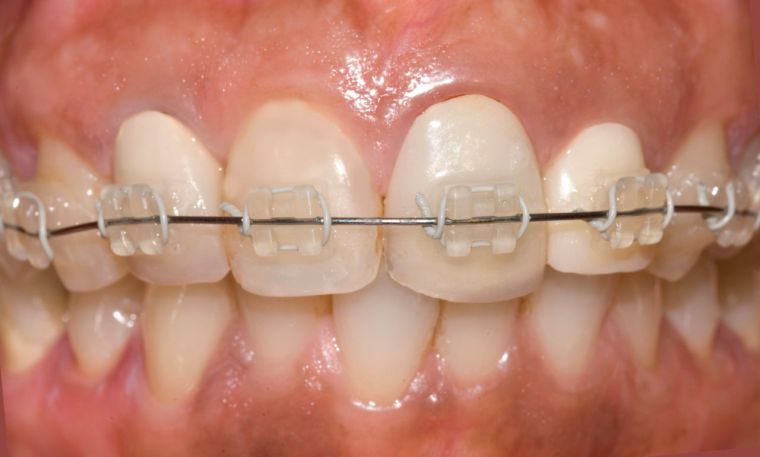
In the photo aesthetic braces - the trend of modern fashion
The device and principle of operation of bracket systems
The bracket system consists of two main components:
- special arc;
- locks or staples that are attached to the teeth.
Locks with a special glue are attached to the teeth on one side, and on the other - to the arc. The arc is in most cases made of special wire.
The peculiarity of the arc is that it keeps the given shape for a long time( it takes 1-2 years to wear the braces, depending on the complexity of the problem).
Braces create a constant pressure on the dentition. Under the influence of this force, teeth change their position, which contributes to the alignment of the dentition.
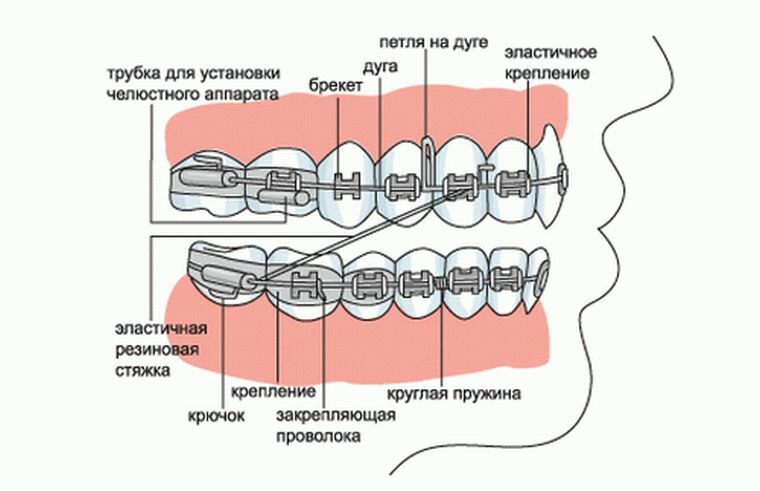
For every taste, color and material. ..
Modern braces are significantly different from the first models. They not only became much smaller, but for their manufacture different materials are used( previously orthodontic devices were made only of metal).
Depending on the material used for manufacturing, these types of braces are distinguished:
- metal;
- plastic;
- ceramic;
- sapphire.
Metal around the head
Braces made of metal are by far the most common. For the manufacture of locks and arcs, steel, titanium, nickel and other metal alloys are used.
Metal bracket systems are used for patients of different ages. Can correct curvature of any complexity.
Modern metal braces are small in size, so they do not cause discomfort and inconvenience to a person. They also have other advantages:
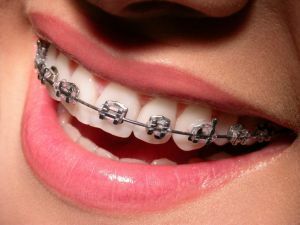
- is affordable;
- easy installation;
- no damage to the cheeks, tongue, or other tissues in the oral cavity;
- high strength;
- good fixation;
- simplicity of care.
The main disadvantages include the occurrence of allergic reactions, as well as aesthetic appearance. Metal braces are noticeable on the teeth, but getting used to them occurs in just 2-3 days.
Plastic systems
Compared with metal braces, plastic braces have a more aesthetic appearance, they are almost invisible on the teeth, especially in the first months of wearing.
Over time, the color of the plastic may change under the influence of food colors, and the bracket system will become more noticeable.
The main advantages of plastic orthodontic devices is an affordable price. The installation is simple, and in the process of application they practically do not bring discomfort.
Sometimes plastic locks are combined with a metal arc. This contributes to greater reliability and efficiency, but at the same time the aesthetics of the devices remain.
Ceramics - it's fashionable and beautiful
Brackets made of ceramics have their advantages and disadvantages. The main advantages of these bracket systems include: 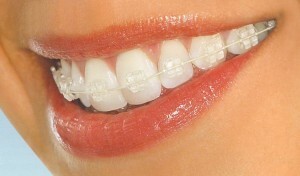
- Strength of .In the process of wearing, they do not break, they keep the given shape well, therefore they are used for leveling teeth of any degree.
- Security .Do not damage the mucous cheeks and other tissues of the oral cavity.
- Aesthetics of the .They have a white color, so they are not noticeable on the teeth. Can be made under the color of the teeth, if they differ in yellowness.
- Not exposed to .Food colors do not affect the color of the ceramic system.
Among the main drawbacks worth noting:
- high cost;
- installation complexity;
- need for longer wearing;
- large sizes of locks that deliver more discomfort.
Sapphire correction systems
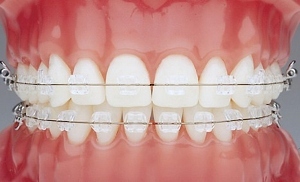 Sapphire orthodontic devices are less popular, because their high cost is too expensive for many patients.
Sapphire orthodontic devices are less popular, because their high cost is too expensive for many patients.
For the production of locks, artificial sapphires are used. They are transparent, therefore imperceptible on the teeth. The advantages are also their high strength.
It is these braces that are best placed for an adult with complex pathologies of the dentition. They are suitable for correcting the most difficult distortions and defects.
The undoubted plus is also that sapphires never cause allergic reactions, and are absolutely safe for human health.
In addition to the high price, sapphire braces have other drawbacks. Their installation is complex, therefore it requires special knowledge from the orthodontist. Also, it is more difficult to care for such systems than for metal ones.
Lingual and classical systems
Depending on the place of attachment, the brackets are divided into classical and lingual. The peculiarity of the latter is that they are attached not from the outside of the teeth, but from the inside.
On the one hand, lingual bracket systems have an undeniable advantage - they are not completely visible. Most often they are chosen by patients who are embarrassed by their appearance.
But at the same time, such systems have a number of drawbacks:
- is difficult to install;
- high price;
- difficulties arising from care.
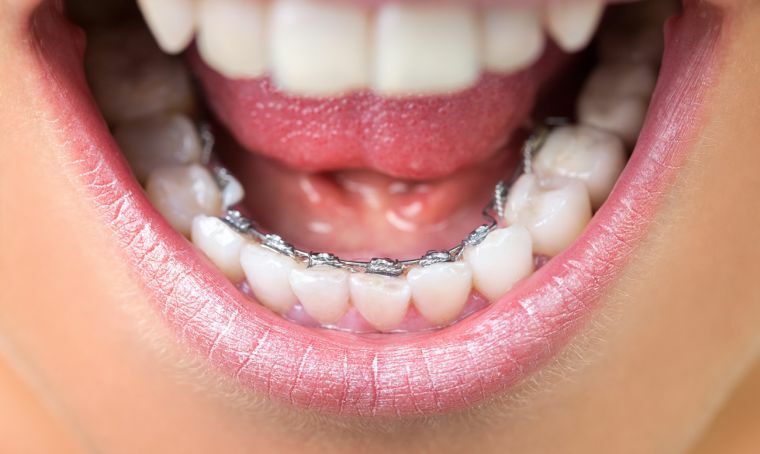
Non-ligand and classical designs
Bracket systems can differ not only in the material of manufacture and the attachment point, but also in the device. Depending on the characteristics of the braces are:
- ligature( classic);
- without ligature( self-ligating).
Ligature braces
The feature of ligature designs is the presence of a special element - ligature. It provides a reliable fixing of the arc in the groove of the lock.
In ligature braces, the arc is fixed motionless. Over time, ligatures lose their elasticity, so you need to regularly visit a doctor to replace them. In the process of leveling, the teeth have to overcome the force of friction.
Classic( ligature) bracket systems allow you to correct any complexity of curvature. The alignment process is long, but due to the attraction of muscle strength to the process, it is practically painless.
In addition, the devices have an affordable price. Can be installed from the outside and from the inside.
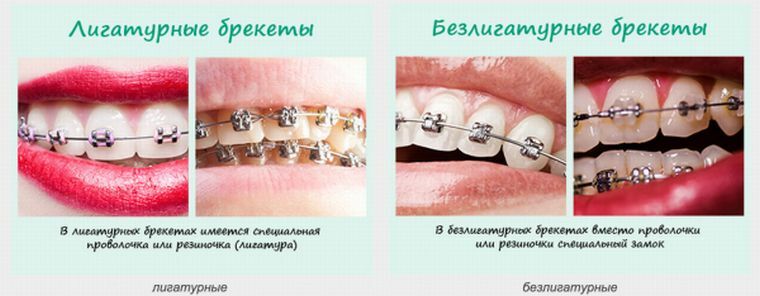
System without ligature
In ligature-free constructions, ligatures are not used. Thanks to this modern development, the time to correct the curvature of teeth can be significantly reduced in comparison with the use of classical braces.
The main feature of self-ligating brackets are special sliding locks. Thanks to them, such devices have acquired many advantages:
- arc replacement occurs faster and less painfully;
- teeth do not have to overcome a greater frictional force, which speeds up their alignment process and reduces pain;
- you need to visit the doctor less often;
- to care for the system is much easier, since there are no ligatures;
- have a more neat look;
- compact size almost does not deliver discomfort.
But the minus self-ligating systems can be called a high cost.
How to choose a bracket system?
Before people who want to have even teeth, the question arises, how to choose a bracket system, what is better to put? Before making a decision, you need to visit a doctor.
When choosing braces, you need to pay attention to the following factors:
- the presence of allergic reactions to certain materials;
- degree of curvature and complexity of the problem;
- aesthetic side;
- financial opportunities.
It is also necessary to take into account the peculiarities of wearing braces, the frequency of doctor's visit, the timing of alignment, the difficulty of care and other features. Orthodontist usually advises which systems the patient can approach, and the latter makes the final decision, taking into account personal wishes and financial possibilities.
The pleasure is not cheap
The price of brackets for the most part depends on the specific type of corrective system. The total cost of bracket systems consists of several components.
It depends on the following factors:
- manufacturing complexity;
- material;
- difficulty of the problem;
- survey and preparatory actions;
- installation;
- follow-up.
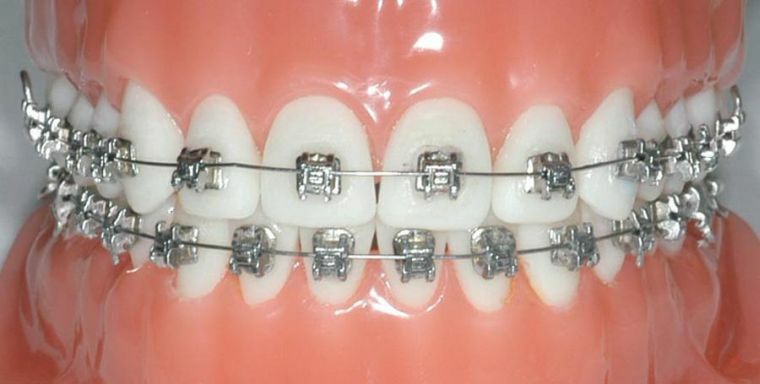
Self-ligating braces are expensive
Average price for RF:
- The most budgetary ones are metal braces. Their cost starts from 7-8 thousand.
- To inexpensive types also include plastic devices.
- But ceramic and sapphire systems are very expensive. The cost of braces for one jaw is in the range of 30-60 thousand rubles. The full course of treatment can reach 200 thousand rubles.
Bracket systems allow anyone to make their teeth smooth and beautiful. A variety of modern solutions can solve almost any problem associated with an incorrect bite or twisted teeth.
When choosing devices, it is necessary to rely on the doctor's recommendations, since it is necessary to take into account not only the cost and aesthetics, but also the complexity of the problem, contra-indications and much more.
